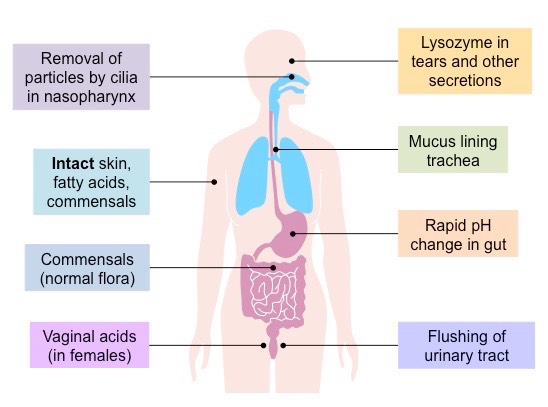Key Knowledge:
|
The first line of defence against infectious disease are the surface barriers that prevent the entry of pathogens into the body
- These preventative mechanisms of pathogenic infection can be categorised as either physical, chemical or microbiota barriers
Physical Barriers
Physical barriers form an external surface that protects the internal structures from the surrounding environment
- Intact skin consists of a dry and thick outer layer composed predominantly of dead cells that prevent external infection
- Mucous membranes consists of a thin region of living surface cells that function to protect internal structures (i.e. cavities and tubes)
- Mucous membranes may be ciliated (e.g. airways) to assist in the trapping and subsequent removal of pathogens
- They can release fluids (tears, mucus) to help wash away pathogens and are supported by physical actions (sneezing, coughing)
Chemical Barriers
Chemical barriers consist of biochemical agents which inhibit the growth and spread of pathogens on external or internal surfaces
- Sebaceous glands secrete chemicals (such as fatty acids and lactic acid) which inhibit microbial growth on the surface of the skin
- Tears and saliva contain lysozyme (enzyme) which can destroy cell walls, while sticky mucins (in mucus) help to clear pathogens
- The stomach and genitourinary tracts both produce acids in order to create a hostile pH range to pathogens in these regions
Microbiota Barriers
Microbiotic barriers consist of the normal flora (commensals) that line specific cavities (such as the digestive tract) in most animals
- By occupying the available space in the intestines, the microbiota prevents the colonisation of these surfaces by pathogenic cells

Plant Barriers
Plants lack cellular defences (unlike animals) and so rely solely on structural and biochemical defences against pathogens
- The thick, waxy cuticle and outer epidermal cells provide a physical barrier for plants in the same way that skin does in animals
- Plants may employ certain structures, including thorns, to deter animals (and hence avoid potential vector-based pathogens)
- When pathogens invade the vascular tissue, layers of thickened cells form and create protuberances (galls) to limit the spread
- Some plants resist disease by producing chemicals (stored in vacuoles) that have antimicrobial properties (e.g. saponins)
- Plants may additionally secrete a range of other anti-bacterial or anti-fungal agents, including resins, tannins and defensins
- Some trees will produce particular oils that repel certain insect pests (and any associated vector-borne diseases)
- Additionally, certain plants may secrete gum around infected areas, essentially sealing the area off prior to abscission (shedding)